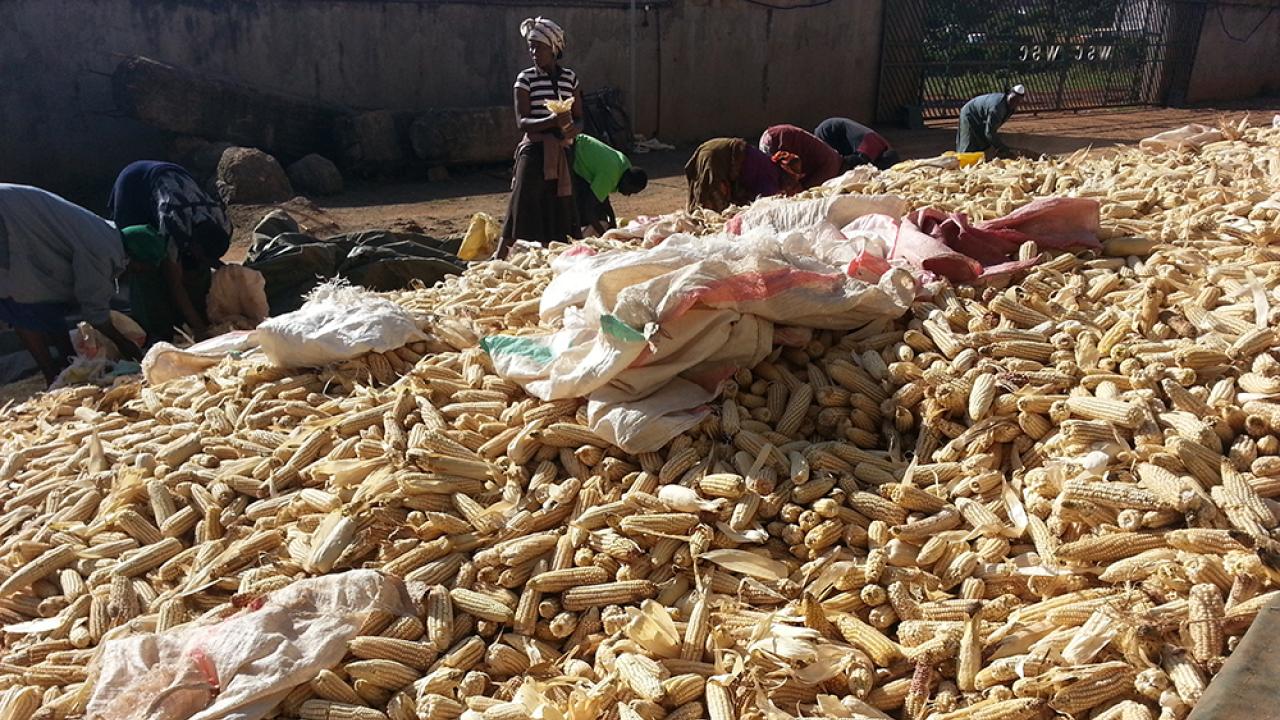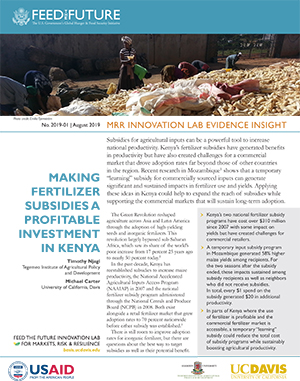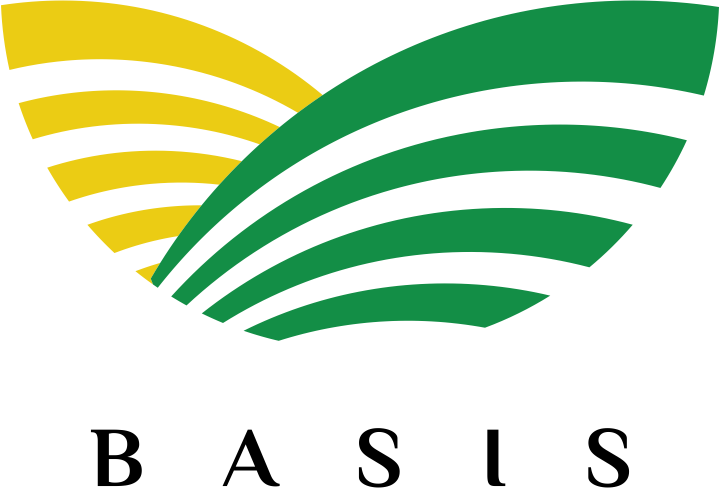
Subsidies for agricultural inputs can be a powerful tool to increase national productivity. Kenya’s fertilizer subsidies have generated benefits in productivity but have also created challenges for a commercial market that drove adoption rates far beyond those of other countries in the region.
Recent research in Mozambique[1] shows that a temporary “learning” subsidy for commercially sourced inputs can generate significant and sustained impacts in fertilizer use and yields. Applying these ideas in Kenya could help to expand the reach of subsidies while supporting the commercial markets that will sustain long-term adoption.
Highlights
-
Kenya’s two national fertilizer subsidy programs have cost nearly $310 million since 2007 with some impact on yields but have created challenges for commercial retailers.
-
A temporary input subsidy program in Mozambique generated 58% higher maize yields among recipients. For the two seasons after the subsidy ended, these impacts sustained among subsidy recipients as well as neighbors who did not receive subsidies. In total, every $1 spend on the subsidy generated $20 in additional productivity.
-
In parts of Kenya where the use of fertilizer is profitable and the commercial fertilizer market is accessible, a temporary “learning” subsidy could reduce the total cost of subsidy programs while sustainably boosting agricultural productivity.
The Green Revolution reshaped agriculture across Asia and Latin America through the adoption of high-yielding seeds and inorganic fertilizers. This revolution largely bypassed sub-Saharan Africa, which saw its share of the world’s poor increase from 17 percent 25 years ago to nearly 50 percent today.[2]
In the past decade, Kenya has reestablished subsidies to increase maize productivity, the National Accelerated Agricultural Inputs Access Program (NAAIAP) in 2007 and the national fertilizer subsidy program administered through the National Cereals and Produce Board (NCPB) in 2008. Both exist alongside a retail fertilizer market that grew adoption rates to 70 percent nationwide before either subsidy was established.[3]
There is still room to improve adoption rates for inorganic fertilizer, but there are questions about the best way to target subsidies as well as their potential benefit. A recent experiment in Mozambique tested a way to structure and target a temporary subsidy to crowd-in investments from farmers who do not receive a subsidy. This network effect could increase the full impact of subsidies anywhere, but only if the investments are profitable for farmers.
Fertilizer Subsidies in Kenya

In 2007, the Government of Kenya introduced the NAAIAP for farmers who still could not afford inorganic fertilizers. The program’s “Kilimo Plus” was a voucher for fertiliser and improved maize seed that targeted small-scale farmers could redeem at private agrodealers. “Kilimo Biashara” linked farmers with input and crop insurance providers with support to establish marketing associations to sell their harvests. By 2016 the program reached 537,218 farmers at a cost of KSh 517 million ($5.1 million).
In 2008 Kenya established a national fertilizer subsidy program in response to the oil price shock that tripled retail fertilizer prices. The program provided all verified farmers discounted fertiliser from the National Cereals and Produce Board (NCPB). The lowest subsidy it provided was about KSh 1,000 ($10) per 50 kg bag but this varied. As of 2018, the program has purchased and distributed 1.3 billion metric tons of fertilizer at a cost of KSh 31 billion ($307 million).
Both programs may have increased fertilizer use but created challenges for commercial fertilizer markets. While the NAAIAP raised maize productivity by up to 30 percent and reduced the severity of poverty by 11 percent,[6] a World Bank evaluation[7] found that government reimbursements to agrodealers were delayed, impacting the confidence in the program and delaying resupplies.
The NCPB-administered program directly displaces retail fertilizer sales because of its structure. The NCPB buys from international suppliers and distributes to farmers through NCPB offices, excluding and undercutting commercial markets. A Tegemeo analysis[8] showed that every 1 kg of NCPB subsidized fertilizer displaced 0.2 kg of commercial fertilizer.
Crowding In Investments
Two key factors that impact a subsidy’s long-term success are whether its cost is sustainable and the inputs are profitable for farmers. Profitability was at the center of an experiment conducted in partnership with the Government of Mozambique and the International Fertilizer Development Center to test a subsidy with a built-in exit strategy. It offered a 73-percent discount on a package comprising 12.5 kg of improved maize seeds and 100 kg of inorganic fertilizer valid for only one use during the 2010-11 agricultural season.
Farmers using the subsidy significantly increased their use of inorganic fertilizer and had significantly higher yields. During the subsidy year, farmers increased their fertilizer use by 33 kg/hectare and had 58 percent higher maize yields. These increases sustained for the two following seasons, with fertilizer at full price.
The program also had a surprising impact on nearby farmers who did not receive the subsides. During the subsidy year these farmers had no improvements in adoption or yields. However, in the two following seasons they substantially increased their use of fertilizer and had significant increases in both maize yields and overall agricultural production.
The yield increases were well worth the cost of the temporary subsidy. Every $1 spent on the subsidy returned $20 in benefits, the majority driven by farmers who did not receive a subsidy.
Beyond a Cash Transfer
Mozambique is a very different setting than Kenya but it does provide insights for how to build self-sustaining input adoption with short-term subsidies. Targeting is key. In Mozambique, the temporary subsidy was a way to overcome a lack of information among farmers who had limited experience with improved inputs. By contrast, of NAAIAP recipients in a Tegemeo sample, 85 percent consistently purchased fertilizer across 2000, 2004 and 2007.[9]
Profitability also drove the sustained adoption in Mozambique, though profitability is not guaranteed. Across Sub-Saharan Africa, the additional cost of inorganic fertilizers is not always profitable enough to justify the cost.
A 2018 review[10] cited three studies from Kenya in the past decade that estimated the average profitability of commercial fertilizer. A ratio of 1.0 or above represents at least breaking even on the investment. A ratio below 2.0 is profitable but does not generally overcome the additional risk of spending more cash on inputs when a drought or flood can wipe out everything. Profitability for fertilizer in Kenya ranged from 1.05 in western and central Kenya to 3.7 in the eastern lowlands.
Subsidies that crowd out commercial purchases function more like direct cash transfers. This puts cash back into farmers’ pockets but at the expense of the commercial market. However, for farmers unfamiliar with or reluctant to use inorganic fertilizers, the experience in Mozambique shows that a temporary subsidy can generate very high rates of return, especially when neighbors see first-hand what is possible.
Timothy Njagi is a research fellow with the Tegemeo Institute of Agricultural Policy and Development.
Michael Carter is the director of the MRR Innovation Lab and a professor of agricultural and resource economics at UC Davis.
[1] Carter, M. et al. 2019. “Subsidies and the African Green Revolution: Direct Effects and Social Network Spillovers of Randomized Input Subsidies in Mozambique.” Working Paper. MRR Innovation Lab.
[2] World Bank, 2018
[3] Ariga, J. et al. 2009. “Private sector responses to public investments and policy reforms.” IFPRI Discussion Paper.
[4] Tegemeo Institute, 2015. “Tegemeo Agricultural Policy Research Analysis (Tapra) Project 2014 Household Survey Report.”
[5] Ibid.
[6] Mason, N. et al. 2017. “The Effects of Kenya’s ‘Smarter’ Input Subsidy Programme on Smallholder Behaviour and Incomes: Do Different Quasi-experimental Approaches Lead to the Same Conclusions?” Journal of Agricultural Economics.
[7] World Bank. 2013. “European Union Food Price Crisis Rapid Response Facility Implementation Completion And Results Report On A Grant Under The Global Food Crisis Response Program In The Amount Of Euro 19.13 Million To The Republic Of Kenya For The Enhancing Agricultural Productivity Project.”
[8] Makau, J., et al. 2016. “An assessment of the effect of a national fertiliser subsidy programme on farmer participation in private fertiliser markets in the North Rift region of Kenya.” African Journal of Agricultural and Resource Economics.
[9] Sheahan et al, 2014. “Targeting of Subsidized Fertilizer Under Kenya’s Accelerated Agricultural Input Access Program (NAAIAP).” Tegemeo Institute.
[10] Jayne, T. et al. 2018. “Review: Taking stock of Africa’s second-generation agricultural input subsidy programs.” Food Policy.
This report is made possible by the generous support of the American people through the United States Agency for International Development (USAID) cooperative agreement 7200AA19LE00004. The contents are the responsibility of the Feed the Future Innovation Lab for Markets, Risk and Resilience and do not necessarily reflect the views of USAID or the United States Government.
